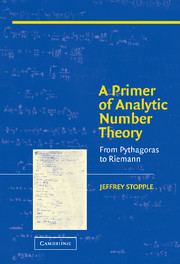Book contents
- Frontmatter
- Contents
- Preface
- Chapter 1 Sums and Differences
- Chapter 2 Products and Divisibility
- Chapter 3 Order of Magnitude
- Chapter 4 Averages
- Interlude 1 Calculus
- Chapter 5 Primes
- Interlude 2 Series
- Chapter 6 Basel Problem
- Chapter 7 Euler's Product
- Interlude 3 Complex Numbers
- Chapter 8 The Riemann Zeta Function
- Chapter 9 Symmetry
- Chapter 10 Explicit Formula
- Interlude 4 Modular Arithmetic
- Chapter 11 Pell's Equation
- Chapter 12 Elliptic Curves
- Chapter 13 Analytic Theory of Algebraic Numbers
- Solutions
- Bibliography
- Index
Interlude 4 - Modular Arithmetic
Published online by Cambridge University Press: 05 September 2012
- Frontmatter
- Contents
- Preface
- Chapter 1 Sums and Differences
- Chapter 2 Products and Divisibility
- Chapter 3 Order of Magnitude
- Chapter 4 Averages
- Interlude 1 Calculus
- Chapter 5 Primes
- Interlude 2 Series
- Chapter 6 Basel Problem
- Chapter 7 Euler's Product
- Interlude 3 Complex Numbers
- Chapter 8 The Riemann Zeta Function
- Chapter 9 Symmetry
- Chapter 10 Explicit Formula
- Interlude 4 Modular Arithmetic
- Chapter 11 Pell's Equation
- Chapter 12 Elliptic Curves
- Chapter 13 Analytic Theory of Algebraic Numbers
- Solutions
- Bibliography
- Index
Summary
Traditional books on number theory that emphasize the algebraic aspects begin with the subject of modular arithmetic. This is a very powerful technique, based on the work of Fermat, Euler, and Gauss. The idea is to fix an integer, n, and group all the rest of the integers into one of n classes, depending on what remainder you get when you divide by n. A more elegant way of saying this is that two integers, a and b, are in the same class if n divides b − a or, in other words, b − a is an integer multiple of n. In this case, we write a ≡ b mod n. (This is pronounced “a is congruent to b modulo n.”) For example, with n = 6, 5 ≡ 17 mod 6, −2 ≡ 4 mod 6, and even 6 ≡ 0 mod 6. Because there are seven days in a week, the fact that 3 ≡ 10 mod 7 means that the 3rd of the month and the 10th of the month fall on the same weekday.
Example 14.0.1. The following steps show that ≡ is an equivalence relation.
Show that ≡ is reflexive, that is, that a ≡ a mod n.
Show that ≡ is symmetric; that is, if a ≡ b mod n, then b ≡ a mod n.
Show that ≡ is transitive; that is, if a ≡ b mod n and b ≡ c mod n, then a ≡ c mod n.
Information
- Type
- Chapter
- Information
- A Primer of Analytic Number TheoryFrom Pythagoras to Riemann, pp. 254 - 259Publisher: Cambridge University PressPrint publication year: 2003
